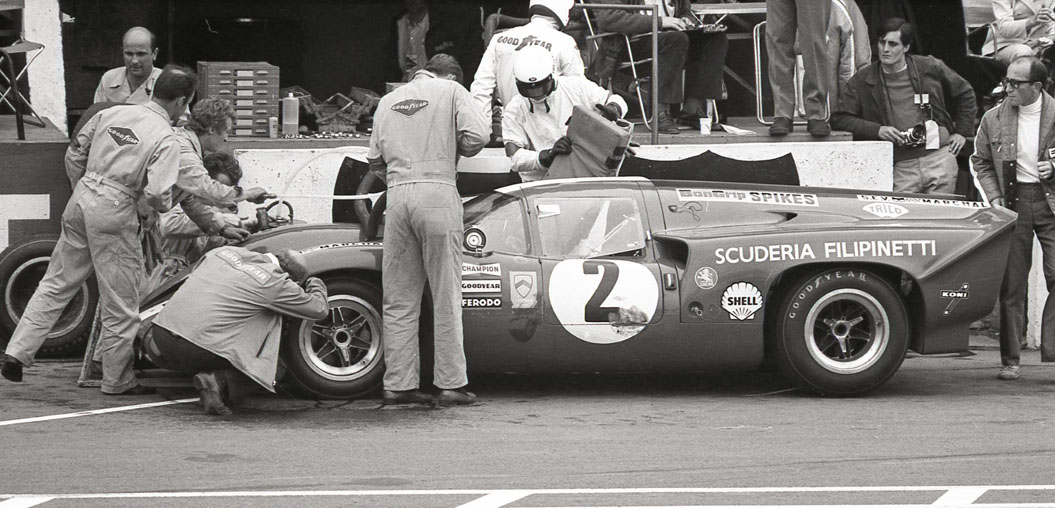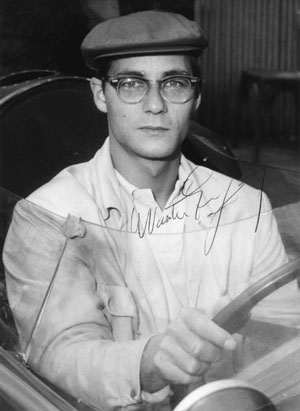Masten Gregory (29 February 1932 − 8 November 1985) was an American racing driver.
He raced in Formula One between 1957 and 1965, participating in 43 World Championship races, and numerous non-Championship races. Info from Wiki
Bio by Stephen Latham
The ‘Kansas City Flash’, Masten Gregory’s early involvement in racing involved drag racing a 1933 Ford Coupe around the city streets plus being a pitman for his brother-in-law Dale Duncan’s race team. Unusually, he would be one of the few drivers who raced wearing glasses, with his vision being so poor that Carroll Shelby, who raced with him, stated ”he couldn’t see shit. His glasses were as thick as Coke bottles.” He also became known for his fearlessness plus his ‘bail-outs’ from cars; if he was about to have a big crash, he would stand up in the car and jump out before it hit anything too solid.
Born in Kansas City, Missouri, his parents divorced when he was very young and his father died when he was three years old and he later used his inheritance to purchase a Mercury-powered Allard. His first race with it was a 50-mile SCCA race in Texas in 1952 though retired from it due to head gasket failure. He installed a Chrysler hemi-powered engine to race at Sebring the following year but retired with rear suspension failure. However, switching to a Jaguar XK120, he won at Golden Gate Park, San Francisco and after taking his first win one headline read “Kansas City Unknown Cops Big Car Race.’
Fast and fearless, he was black flagged at a race at Chanute Air Force Base but when he arrived for his next race he had black-flags painted on his car, which were used as a background for his car number. He had a win at Offutt Air Force Base in Omaha, Nebraska, ahead of Carroll Shelby in an ex-works 1952 Ferrari 340 ‘Mexico’ Coupe. There were also podium finishes at Bergstrom, Lockbourne, Janesville and Madera and his performances gained him an invitation to compete in his first international sports car race, the 1000 km Buenos Aires in Argentina in 1954. He performed well in it, though eventually finished fourteenth due to water pump problems.
Throughout 1954 and 1955, he competed in numerous races in Europe, usually driving Ferraris. Although he was entered for Le Mans, his co-driver Mike Sparken retired before Masten got a chance to drive. However, driving a Ferrari 340 America and a 375, he won at Aintree and the Nassau Trophy at the Bahamas Speed Week plus took podiums at Monsanto, Goodwood and the Coupe de Salon. In shared drives there was a fourth place at the Reims 12Hours with Clemente Biondetti and ninth with Bob Said in a Ferrari Mondial in the Tourist Trophy.
The following year, racing a Maserati 300S and a variety of Ferraris, he won at Monsanto and Palm Springs plus had podium finishes at the GP Bari, Nurburgring, Porto, Palm Springs and the Nassau Trophy. He retired from the Sebring 12 Hours though he and Carroll Sheby finished ninth overall (and won their class) with a Porsche 550 Spyder at the Tourist Trophy. In 1956, he spent most of the year driving in various SCCA races and had victories at Torrey Pines, Thompson, Nassau plus podiums at Dodge City, Beverley, Thompson and the Nassau Trophy.
After his impressive victory in an Argentine 1000Km (with Luigi Musso and Eugenio Castelloti) he was offered the chance to fill in for Peter Collins’ Lancia-Ferrari D50 in a non-championship F1 race plus a contract to drive for Ferrari as a fourth driver. However, he turned it down as it meant he would only race in a couple of GPs a year so chose instead to drive for Mimmo Dei’s Scuderia Centro Sud. A privateer team, he raced their Maserati 250F at Monaco and became the first American to score a debut podium finish in F1 with his third place finish. Following this was an eighth place finish in the German GP at the Nurburgring, and at Pescara, a difficult circuit, he qualified seventh and started on the third row but finished fourth, behind Stirling Moss, Juan Manuel Fangio and Harry Schell. There was another fourth at the Italian Grand Prix at Monza and he finished sixth in the World Championship, despite only competing in half of the races.
1958 saw him continue with the Maserati 250F again for Scuderia Centro Sud but he injured himself bailing out of his car at speed during a sports car race at Silverstone. The injuries meant he only competed in four Grands Prix that year but despite retiring from two races he finished fourth in Italy and sixth in the season ending Moroccan Grand Prix.
He raced for Cooper in 1959 and besides third place at Zandvoort, he took a career best second place finish at the Portuguese GP at Monsanto plus took pole position and set a course record in a non-championship GP at Aintree. However, he was injured in a sports car race at Goodwood after bailing out of his Jaguar when his steering failed and he missed the final two Grands Prix as a result. At Avus in Germany, he stayed with the much faster Ferraris by sticking in their slipstream, driving with one hand on the wheel in order to hold his helmet’s visor closed with the other.
Despite his performances he did not stay with the team for 1960 and over the next few years raced for various teams, including Scuderia Centro Sud, Camoradi International, UDT Laystall, Tim Parnell, and Reg Parnell Racing.
He continued in F1 until 1965 and his best results occurred during 1962 when he drove a Lotus 24 for the UDT Laystall team and finished seventh in the British GP at Aintree and sixth in the US GP at Watkins Glen. He also won a non-championship F1 race at Karlskoga plus was second in Roskilde and during the French GP, he was running fourth behind fellow American Dan Gurney (who went on to win the race in his Porsche) before having to retire due to ignition problems.
In his sports car racing career, at the 1960 Le Mans 24 Hours, despite having to retire due to electrical problems, Masten recorded the fastest lap of the race in his Birdcage Maserati T61 during the opening laps. In 1961, he won the Nurburgring 1000km in a Birdcage Maserati with Lloyd ‘Lucky’ Casner despite having no sponsor and having to borrow tyres after the final practice. Back at Le Mans in 1961 he and Bob Holbert finished fifth overall and first in class in a Porsche RS61 Spyder and the following year he won the Canadian GP sportscar race at Mosport Park in a Lotus 19-Climax.
In 1964’s Le Mans race, he was teamed with Richie Ginther in one of Ford’s GT40s and the team led for a period early in the race. However, a slow pit stop caused Masten to come out in second place though they held the position until the car retired in the fifth hour due to gearbox problems. Victory finally came the following season with North American Racing Team’s Ferrari 275 LM and he and Jochen Rindt had an average speed over the 8.365-mile course of 121 mph. It was the first time that an American entry had ever won the race.
1965 saw him race at the Indianapolis 500, in a BRP-Ford sponsored by his stepfather, George Bryant. Although he qualified on the last row for the race, he passed fourteen cars on the opening lap and was running fifth before having to retire due to engine problems.
Other results included a second place finish (with John Whitmore) in a Ford GT40 in a 1000Km race at Monza in 1966; a class win and fourth place overall in a Porsche 908/2 (with Richard Brostrom) at the 1969 Austrian GP at Zeltweg plus third with Toine Hezemans in a Alfa Romeo T33/3 in 1970’s Sebring 12 Hours. However, after his friend Jo Bonnier was killed at Le Mans in 1972, Masten decided to move away from competitive racing.
Masten had been so dedicated to getting a competitive F1 drive that he moved his wife and children to Italy during the 1950s, into a villa across from the Ferrari factory. After racing he later worked as a diamond trader in Amsterdam but sadly, at only 53 years old, he died in his sleep in 1985 when he suffered a heart attack at his home in Porto Ercole, Italy.
Masten had a very daring and aggressive racing style and said in an interview “frankly, if I couldn’t go motor racing I would have to do something else involving hazard because it is the moment of risk that makes the rest of life bearable, valuable or delightful…When I was about 32 or 33 years old, it came to me, that up until that point my life I had never believed I would live to be 30. I hadn’t made any plans because it didn’t seem worthwhile. Stirling Moss told me flatly that I was going to kill myself soon after I got to Europe. Everybody thought I’d kill myself, and looking back I’m surprised that I didn’t. I was driving mainly on reflexes. I really didn’t know anything about racing. I just had quite a bit of natural ability, I guess.”
Dan Gurney thought very highly of him, as a person and as a driver, declaring he had “a special gift, a gift to drive fast, and that he was brave” while Carroll Shelby said that Masten could be as fast as anybody could on any given day. Jim Clark (who considered Masten to be his hero), raced at Goodwood in a sportscar race in 1959 and said he realised he himself had become a star driver after he was able to match Masten’s lap times in the very same car. He told in ‘Jim Clark At The Wheel’ that, “Masten Gregory, who was driving the Ecurie Lister, was one of my big idols at that time. I don’t know quite why Masten should have been my hero then but I remember thinking that he was really top line with that big hairy Lister-Jaguar and I reckoned that he drove it really well.” He recounted a tale from a 1958 sports car race at Spa-Francorchamps, in Belgium, where he was entered with a Jaguar D-Type and how Masten’s race-winning performance nearly put an end to his own career while being lapped. “Suddenly, there was an almighty howl of sound, a blast of wind, the whole car shook, and Masten went steaming past like a bat out of hell. He was well out in the lead with the Lister-Jaguar all sideways, his arms crossed up and fighting the steering. I remember having a sudden twinge of shock and thinking, “To heck with this, if this is motor racing I’m going to give up now”. It really put me off. I didn’t think anyone could drive a car as quickly as that…”
Masten Gregory – Kansas City Chief – from ![]()

Gallery F1 Sport cars Indy




